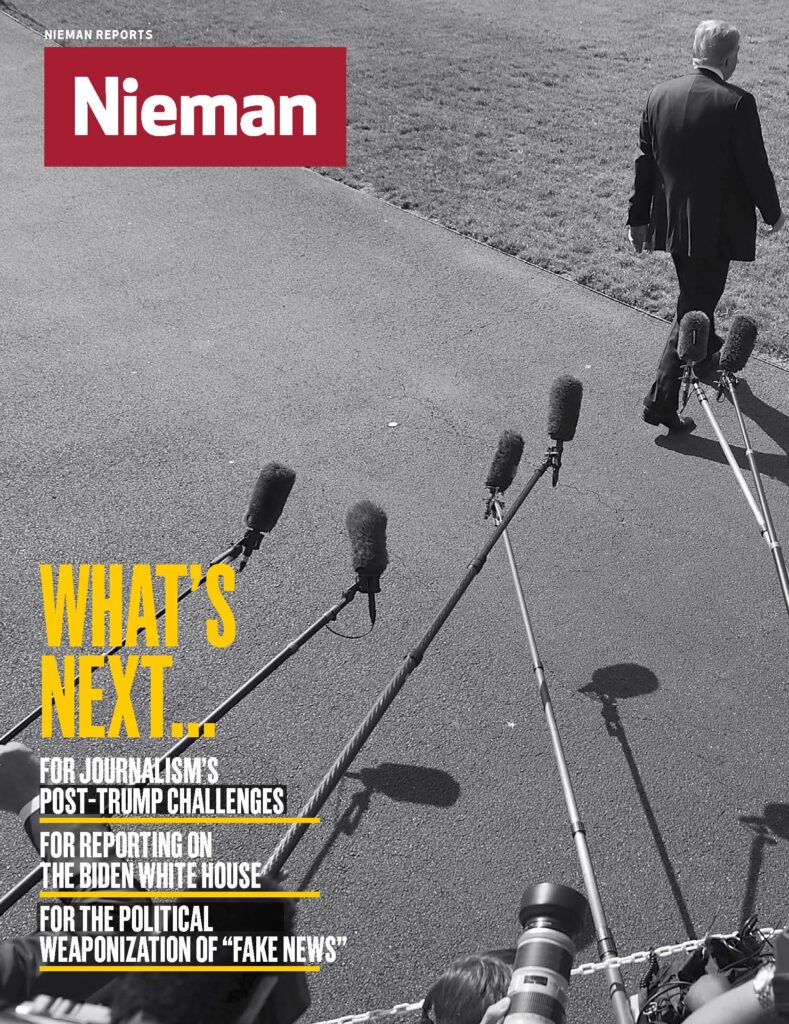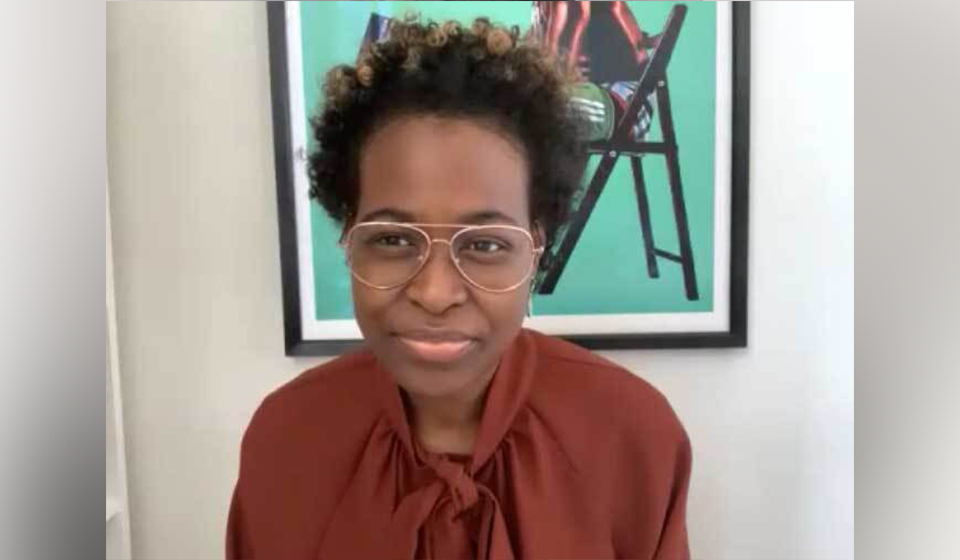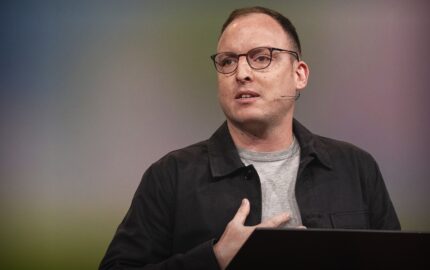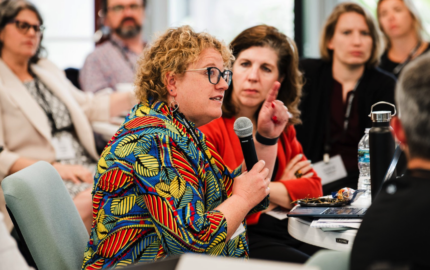
As they prepare to cover the post-Trump era, political reporters in particular will face critical challenges, and the lingering issues of media mistrust, conspiracy theories, and journalism’s economic sustainability will continue to plague the media no matter who is in the White House.
Errin Haines is editor-at-large for The 19th*, a nonprofit news outlet covering the intersection of women, politics, and policy. Launched amidst the coronavirus pandemic and a national reckoning on race in August 2020, the nonpartisan newsroom is named after the 19th Amendment, which granted white women in America the right to vote; its logo includes an asterisk to recognize those who were excluded — namely, Black women — from accessing the ballot and those who continue to struggle to do so.
Before joining The 19th* as a founding member, Haines was the national writer on race and ethnicity for The Associated Press. She joined The 19th*, she says, not just because she believed in CEO Emily Ramshaw’s vision for creating news coverage for and by women, but to help shape the organization’s vision and culture — something made all the more important during this pivotal moment for the country and for its media. “We’re building culture instead of trying to fix it, especially [as] the national reckoning came around,” says Haines. “That hit a lot of American newsrooms. Newsrooms are an institution in this country; they’re not immune from this conversation.”
Haines, an MSNBC contributor who has also worked at The Washington Post, the Los Angeles Times, and The Orlando Sentinel, helped bring national attention to the Breonna Taylor case when she spoke to Taylor’s family and The 19th* ran the story — which was co-published by The Washington Post — back in May. Haines discussed this and much more during a talk with Nieman Fellows in the fall. Edited excerpts:
On why she joined The 19th*
Errin Haines: A year and a half ago, I was on the primary campaign trail and was frustrated about the way that gender and race were being discussed. It felt like we hadn’t learned that much from 2016 in terms of the narratives that we were using to frame the stakes of this election and who and where we were as a country. My now boss, Emily Ramshaw, reached out to me out of the blue. I did not know her at the time.
She told me her vision for wanting to start this newsroom. While I initially thought it was a great idea, I was like, “Get back to me when you have some money.” She took that as a challenge, raised the money, and was like, “OK, come on. Let’s go do this.”
I’d wanted to be the Associated Press’s national writer on race from the time I was an intern at the AP — that was a long time ago. What ultimately ended up with me making the decision to leave AP and start this new thing was that I didn’t feel like the issues that were inherent in political journalism coverage were going to be fixed fast enough and structurally by staying there. I felt like the only way to fix that was to start over. So that’s what we did. We launched in January, a week before the Iowa caucuses. Obviously, if you’re a political reporter, covering a presidential election is like the Super Bowl. This was certainly the most consequential election I felt I was ever going to cover.
Being out on the campaign trail in the primary, being in Iowa, New Hampshire, and South Carolina, carrying the banner of The 19th*, and having so many people feel like this was something that was not just overdue but really urgent.
On the asterisk in The 19th* logo and how it guides coverage
The 19th* launched in the centennial year of suffrage, which we were certainly marking but with that asterisk. We knew when we were starting this newsroom that Emily wanted to call it The 19th. She also did have some trepidation about that because she understood that not all women got access to the ballot when the 19th Amendment was passed.
I said, “Well, let’s call it The 19th but put an asterisk on it in recognition of the Black women who, frankly, were sacrificed so that the white women could get the right to vote at their expense.” That’s what we did.
The asterisk has become a North Star for us in terms of thinking about coverage, in terms of thinking about who is not being seen and heard in this democracy and wanting to bring them into that conversation.
Yes, we are covering the intersection of race, politics, and gender. We also are a very intersectional newsroom that looks for the connections with other marginalized groups off the coasts to bring in.
What I’ve heard over and over again is that there are too many people who want to engage in this conversation who feel excluded or who don’t feel welcome to do that in their communities, in their own families even, because of how divisive things are now.
What we say is that we try to be a home for all people, even if they don’t want to necessarily live here. That’s across the political spectrum. That’s people who are voting, people who are not yet voting. We want them to feel empowered so that they can get engaged in this democracy.
We believe that all issues are women’s issues and also that we are the majority of the electorate. We shouldn’t be talked about like a special‑interest group anymore. In the nine months that we have been in existence, that is what we have been trying mightily to do.
The pandemic, frankly, gave us another lane of coverage to expose inequality in this country specifically around women, communities of color, other marginalized folks.
When the campaign trail dried up and everything basically went virtual, there were a lot of political journalists who were like, “Well, what the hell am I supposed to do now?” Because we pivoted and focused on the pandemic and then later the national reckoning on race — which is arguably the other pandemic — showing people how that is political and how that is motivating people in this election year, that gave us a lane to absolutely still be in existence. It made our work still feel just as urgent.
On bringing national attention to the Breonna Taylor case
The Breonna Taylor case came up around the same time as Ahmaud Arbery’s case. You saw the hashtag #runningwithahmaud — that was getting a lot of attention. Ben Crump, [an American attorney specializing in civil rights cases] who I’ve known for a long time, all the way back to covering the Trayvon Martin case, reached out to me and said, “Look, there’s another case that is pretty egregious that is getting hardly any attention, and I need your help.”
He tells me about Breonna Taylor, which was a horrific story. Then he tells me that she was killed in March. By the time that he and I are talking, it’s May. I’m like, “Well, how has it been two months, and nobody really has heard about this, and especially given that she was an essential worker?”
She was an EMT. He’s like, “Well, yeah, nobody’s really written about this nationally. And her mom and her sister are frustrated by this and they want to talk. And I think they should talk to you.”
I immediately was like, “Yes. Absolutely. Yeah, we’re doing this because her story needs to be out here. The fact that she is not a trending hashtag … Not that Ahmaud Arbery shouldn’t be, but Breonna Taylor also should be” was my calculation.
It was not a long conversation. I will say that my bosses did not immediately get that this was a story for The 19th*. Again, using the vehicle of the asterisk we talk about, the asterisk is shorthand for us. If we say, “What is the asterisk here?” That’s like, “Why is this a 19th story?”
The asterisk, for me, was that gender was one of the main explanations for why her case had not gotten more attention. Yes, there was no body‑cam footage. There wasn’t video of what had happened to her.
I know the videos tend to get more attention because there’s more proof for people, if you will, that these kinds of things happened. But it felt like the fact that she was a Black woman was part of why people didn’t know about that case. I wanted to put it out there, which is exactly what we did. As a result, she becomes a hashtag and people start paying attention.
Everything else that flowed from writing the first national story about that case and putting it on people’s radar, and getting it trending, and getting people to say, “Hey, what happened in Louisville?” felt important and definitely in line with our mission, but it was definitely a result of the source building that I’d done over a long time as well.
On covering race
Barack Obama’s election is what made [news editors] say, “Oh, wait. Maybe race is a story worth covering.” They got it wrong in terms of the post‑racial myth and thinking that we had solved racism with the election of Barack Obama. In fact, we now know that that unleashed something that had gone somewhat underground prior to his election.
Even before I was officially the national race writer at AP, because it is my belief that race is the unfinished business of this democracy and the central story of America and the most important beat in journalism because it touches everything, I was not ever somebody who felt pigeonholed by this coverage or that it was going to hold me back in my career in some way.
Even now, as a political journalist, I feel like it is easier to learn how to cover politics than it is to cover race. You can see that in the political coverage. Most of these people don’t have any idea what they are looking at when they are looking at issues of race when they appear in politics as they frequently will and do. It is the story of our time.
I have never backed down from that. Part of the reason for that is maybe how I got my start in journalism. I started in Atlanta at the weekly Atlanta Daily World. I was still in college, but I needed some experience. I went over to this paper and said, “Hey, I could use some clips.” They were like, “Can you start today?” I’m like, “Hey, great.” What I learned from the year that I spent there was that our stories were important.
Writing about Black folks and writing about them in their totality, not just tragedy or showing up when there was something wrong but covering every aspect of Black life and putting those stories on the front page of that newspaper told me that our stories were valid, that they mattered, and that I didn’t need to explain to somebody why they should be done.
I’ve carried that with me throughout my career. It has served me well. What’s interesting is, it wasn’t until I came to The 19th* that I had the luxury of thinking about my gender as much as I think about my race.
When we talk about feminism and why that seems to be the purview of white women, it’s because white women don’t think about their race that much so they can focus on their gender, which is the thing that they feel holds them back.
For me, I’ve spent so much of my career, so much of my life thinking about what it means to be a Black person in America. Now, I get to think about what it means to be a woman in America. Even still, I don’t feel like I divorce that from being a Black woman in America.
On the importance of representation in the newsroom
This experience [of building The 19th*] has reinforced for me how much representation matters. The fact that we have been able to create a more diverse politics team than most of the existing politics teams. It hasn’t even been nine months. We started with five people. Our staff is now nearly two dozen.
We have grown even in a pandemic and managed to do it in a diverse way. That takes away the excuse, for me, that these people are not around, available, or qualified, or whatever. I don’t want to hear that anymore. We got so many applications. We had an embarrassment of riches, frankly, to choose from when we were hiring for this newsroom.
Also, we hear over and over again people who are seeing themselves in this coverage, seeing themselves in conversations about our democracy on our site in a way that they have not seen in legacy media. That means a lot. That’s what we are here for. We have reporters not just in Washington but all over the country.
That helps in terms of the perspective that we bring to the journalism. I do think that part of that is also about valuing people’s lived experience as an asset to the journalism as opposed to a liability to the journalism. Those are some of the things that we have learned in the short time that we have been in existence about what is possible if you are intentional.
On funding
As far as funding models, at The 19th* we very much believe in the nonprofit business model for newsrooms. We feel like that is the future. It definitely gave us some flexibility and agility in terms of our ability to galvanize financial support for our newsroom.
We have exceeded expectations in terms of the support that we’ve been able to get from private donors, philanthropy, and also small‑dollar donations from our members who believe in what we’re doing and who want to support our journalism. We have been very clear from the beginning our journalism is free to consume and free to republish.
That doesn’t happen without support from the coalition of funders that we have been courting since day one. We have corporate support too but have not been as reliant on that. That has not been as robust as it would have been if we weren’t in the pandemic.
On covering LGBTQ issues
Even in the midst of this pandemic, it was really important for us to prioritize the hiring of an LGBTQ reporter as part of our roster.
We are committed to equity and to amplifying the voices of marginalized folks. We got a ton of applications for that job.
To have a mainstream outlet that is attempting to integrate this coverage into our overall coverage felt very important to us. It felt important to them. Kate Sosin, who is the reporter that we hired to do this work, has been doing amazing reporting already in the short time that they’ve been onboard with us.
I think about a couple of stories around the election that I felt like were so smart. One, they wrote about the idea of the equality vote, which is a constituency that is even larger than the white evangelical vote in this country. We’re talking about people who know and love someone who is LGBTQ. Because of that, that person is on their heart and mind when they go into the ballot box. Even if it is not an issue that is affecting them directly, because it affects somebody that they love, they are now involved and invested in politics on behalf of that person, showing up politically for that person.
Another story that Kate did that was really good was about the issue of transgender voters and how they could be suppressed in this election because of voter ID. Sometimes their lived identity doesn’t match their paperwork. They could be turned away at the polls for that reason.
On practicing diversity, equity, and inclusion
Haines: We have known for a long time what the prescriptions are for improving diversity in coverage and in newsrooms. The Kerner Commission report laid it all out and we need to pick that document back up, dust it off, and do what it says. That is where I would start.
The key is being intentional. I think, for example, what the L.A. Times, has been doing is remarkable. They seem to be taking this very seriously. The new Washington bureau chief is now a Black woman, which feels very important, Kimbriell Kelly, who was formerly at The Washington Post.
They just published this huge race series where they’re confronting their own past coverage and approach to this work and also their newsroom culture. That is a very important step in the journey that they are on. I do also think that newsrooms have to recognize that this is a journey.
I don’t want folks to get racism fatigue and say, “Oh, well, you know, we did three months. I’m tired. This is hard. I don’t wanna keep going. I just want to move on from this.” If you’re going to address this, [acknowledge that] we are all at the beginning of this process. It’s not just, “Oh, man, last summer was rough. Phew, glad we don’t have to deal with that anymore.”
No, this is ongoing work and an ongoing commitment. Getting honest about and being in conversation with marginalized folks within your newsroom is very important. If you don’t have a whole lot of them, you should ask yourself why you don’t have a whole lot of them. What are you going to do about it?
That doesn’t necessarily mean firing a whole bunch of white men. It means, “Hey, look, we’re going to commit to hiring a more diverse staff. We are going to add people and the people that we add are going to be more diverse and reflective of where we are as a country.” That’s the challenge.
I keep saying this: “Don’t forget that whiteness is an identity that needs to be interrogated in this moment. We need to be asking ourselves, what does it mean to be a white person in America right now and talk to people about that.”
So many times, I get questions from white journalists who are like, “Oh, should I be covering these communities of color?” It’s like, “Well, you can start with your own community and write many stories about race if you wanted to do that.”
That is an editorial choice that more newsrooms need to start thinking about and not just extremist groups. Regular white folks and what they think about this democracy and how that is informing how they move through society.
On reaching all women
Something that we are committed to at The 19th* is trying to be that audience for all women. For us, that includes conservative women, who we believe are trying to engage in good faith around conversations about this democracy.
There are some people who are on the extremes in either direction that we’re just not going to reach. It doesn’t matter how many stories we write or how many different people we try to include. Those people are not persuadable. We recognize that.
What we do believe and are being very earnest about is trying to reach the folks who are not at the ends of those spectrums. We feel like it’s what’s missing, not just in our democracy but in our journalism.



